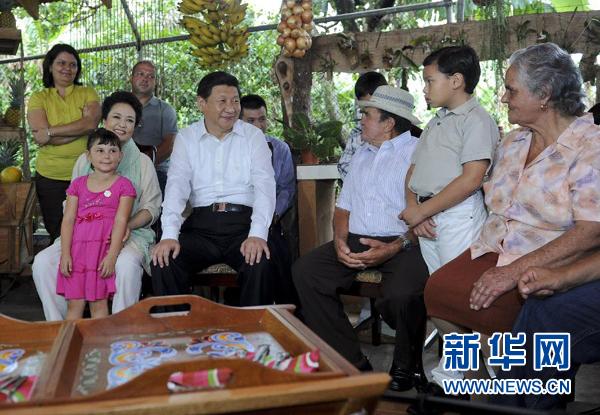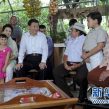
An Equal and Opposite Reaction? Xi’s Grand Tour of the Americas
Publication: China Brief Volume: 14 Issue: 16
By:

This July, Chinese President Xi Jinping embarked on state visits to Argentina, Cuba and Venezuela and attended a summit of the loose group of major developing countries known as BRICS (Brazil, Russia, India, China and South Africa) in Fortaleza, Brazil. This was his second trip to Latin America in less than two years in office, following a previous tour of the Americas in 2013 which included Mexico, Costa Rica, and Trinidad and Tobago.
China’s influence in the region has grown rapidly in recent years, facilitated by the rapid increase in bilateral trade and investment, which as of 2013 stands at $252 billion, second only to the United States. China also appeals to the antipathy of many Latin American leaders toward the United States. Illustratively, this past January the Community of Latin American and Caribbean States (CELAC) in Havana established a China-CELAC forum excluding the United States and Canada.
Historically, China has shown little inclination to engage politically or strategically with Latin America, conceding leadership to the United States due to its manifest advantages, such as proximity and long historical involvement in the region’s affairs. This ambivalence, however, has rapidly evaporated due to China’s growing commercial interests, U.S. interference in East Asia and fears of encirclement through bodies such as the Trans-Pacific Partnership.
Although China and the countries visited this year signed a large number of deals, many in Latin America have expressed doubts about the benefits of Chinese participation in the region. In the long-term, this skepticism may impede China’s ability to form strategically significant partnerships.
Venezuela
Venezuela appears to offer the most fertile ground for Chinese efforts to exert influence and expand profits in Latin America. Antagonistic to the United States, energy-rich and in need of new export markets due to decreasing U.S. demand, Venezuela is also beset by rampant inflation, a chronic shortage of consumer goods and capital, partly as a result of President Nicolás Maduro’s commitment to increase public spending to secure his election. China may also displace the United States as the nation’s largest trading partner next year. These factors have encouraged Maduro to attempt to consolidate a “strategic future alliance” with China (El País, September 25, 2013).
During Xi’s visit to Venezuela this year, the two countries signed 38 agreements in the areas of technology and innovation, petroleum, mining, industry, finance, housing, construction, transport and agriculture. The accords mainly reiterate previous agreements reached when Maduro visited Beijing in September 2013, which also included a $5 billion credit line to be incorporated into the China-Venezuela fund and a 60,000-hectare land concession to a Chinese agricultural company. Additional agreements include a mineralogical survey of the country and a feasibility study of development at the Las Cristinas gold mine. Maduro also proposed the creation of a China-Venezuela commission to plan Venezuelan development for 10 years.
The main destination of Chinese investment is Venezuela’s oil sector. On September 19, 2013, oil minister Rafael Ramírez announced that the China National Petroleum Corporation would invest $28 billion in projects at the Orinoco Petroleum Belt. This was boosted by another announcement by Ramírez that Sinopec and Petróleos de Venezuela, S.A. would establish a joint venture to develop the Campo Junín 1 oil field in the region, with China promising to invest $14 billion (El País, September 25, 2013).
A number of important deals concern the $36 billion Joint China-Venezuela fund set-up in 2007, through which China finances Venezuelan national projects by receiving crude oil in payment. The fund was divided into three tranches, paid in installments in 2007, 2009 and 2013 (El Universal, July 23). The value of the crude is calculated using below-market reference pricing, thus significantly increasing effective loan financing costs. Money loaned by China to the fund is almost always committed to the purchase of Chinese goods and services (El Mundo, April 21). The fund is augmented by the Fondo Gran Volumen Largo Plazo, constituted in 2009 and administering $10 billion and RMB 70 billion ($11.4 billion) (AVN, October 25, 2012).
Many Venezuelan public figures have criticized these loan arrangements. In 2011, the then-governor of Táchira state, César Pérez Vivas, noted that the loan-for-oil deals were significantly below cost and pleaded with President Hugo Chavez to stop “mortgaging the nation” (El Universal, November 20, 2011). In 2013, Julio Montoya, President of the Permanent Commission on the Environment, Natural Resources and Climate Change, stated that Venezuela was receiving a bad deal. He asserted that it was impossible to quantify the total value, because the Venezuelan government uses the Economic and Social Bank of Venezuela administered through a Singaporean bank that is not controlled by the treasury inspector’s office and hence cannot be monitored by the National Assembly (Informe21, September 20, 2013). “We’re talking about financing more expensive than what we used to get from the IMF [International Monetary Fund], which was already obscene.” He explained that China supplied funds on the basis that projects in Venezuela had to be contracted, controlled and equipped by Chinese firms adding to the cost of servicing Venezuelan debt. Comparing the Chinese fund with the IMF: “they are more expensive, we pay them with oil and they kill our jobs,” Montoya stated.
José Guerra, economist and ex-chief of investigations at the Central Bank of Venezuela (CBV), stated in September 2013 that the Chinese loan easily exceeds the international reserves of the CBV: “It is difficult to determine the real contractual terms and hence the true economic impact on the nation… it is also questionable that this debt, denominated in foreign currency has not been approved by the National Assembly as demanded by the Organic Administration Law of the Public Sector” (El País, September 25, 2013).
President Maduro has energetically defended the fund, claiming that conditions are much more advantageous than those obtained from the IMF prior to the arrival of “Chavismo” and that IMF loans were predicated on cutting public spending. Moreover, he asserted that previous IMF money did not arrive in the country but instead remained in the accounts of those who had negotiated the loans. “We are looking for money for projects, not to put us in debt,” he added, speaking from a Chinese automobile factory in the State of Aragua (El País, September 26, 2013).
Argentina
Xi’s visit to Argentina was particularly opportune: The country is resource-rich, embroiled in diplomatic disputes with the United States and in urgent need of foreign capital to avert a currency crisis. China is now Argentina’s second-largest trading partner, behind the United States, and the country’s third largest foreign investor, raising Argentine hopes of counterbalancing the United States. China has also traditionally supported Argentina’s sovereignty claims over the Falkland Islands, which China considers a legacy of “imperialism and colonialism” (People’s Daily, June 26, 2012).
On July 18, 2014, Presidents Cristina Kirchner and Xi signed 20 agreements, including a cooperation agreement to manufacture heavy water pressure tubes used in CANDU (CANada Deuterium Uranium) pressurized heavy water nuclear reactors. China also agreed to finance, build and equip Argentina’s fourth nuclear power plant, the 700-megawatt Atucha III CANDU-6 heavy water natural uranium reactor. The Industrial and Commercial Bank of China will provide $4.7 billion to fund the construction of two hydroelectric dams in the province of Santa Cruz. China will also invest $2.1 billion to renovate the 1500 km Belgrano Cargas railway, which will include 100 locomotives and 5000 wagons with Chinese components (La Nación, July 19).
The most interesting agreement, however, relates to a three-year $11 billion currency swap between the Chinese and Argentine Central Banks, which some have viewed as a trial effort to internationalize the renminbi.
President Kirchner stated that: “Now is the time to cherish the magnificent opportunity that we have in the world, which is returning to multipolarity… In little time, China will become the largest economy in the world.” In addition, official statements repeatedly asserted that China and Argentina would act as guardians, protecting the interests of developing nations from U.S.-led pressure.
Not all in Argentina have been impressed with the Chinese agreements, especially in relation to the currency swap. Aldo Pignanelli, the former president of the Argentine Central Bank and economist for the opposition Frente Renovador party, stated that the renminbi cannot be considered an international currency and that what China has done is “provide credit to import Chinese machinery and equipment.”
BRICS
In long-term geopolitical terms, the most productive of Xi’s activities may be the BRICS summit in Fortaleza, Brazil, which included the consolidation of agreements to establish a BRICS development bank headquartered in Shanghai, with initial capital of $50 billion, later planned to rise to $100 billion. China will provide $41 billion with Brazil, India and Russia providing $18 billion each and South Africa $5 billion (O Global, July 16).
In Brazil, Xi and President Dilma Rousseff signed 32 agreements ranging from cultural exchanges to trade deals, including the sale of 60 commercial jet aircraft from the Brazilian aircraft manufacturer Embraer SA, valued at $3.2 billion, and the construction of a rechargeable electric vehicle battery factory (Bloomberg, July 17). The China Import-Export bank and the Bank of China opened credit lines of $5 billion and $2.5 billion, respectively, to the Brazilian mining company Vale to buy ships, equipment and services from Chinese firms.
Conclusion
Chinese media have been explicit in describing Xi’s activities during the July tour, especially the Fortaleza declaration as a counterstrike (nixi) against Western, particularly U.S., domination of organizations such as the IMF and the World Bank (China Youth Daily, August 4). Additionally, the choice to visit three countries particularly antagonistic to the United States—Cuba, Argentina and Venezuela—may suggest that Xi sought to respond to U.S. interference in Asia, while at the same time as furthering Chinese commercial interests.
However, despite the region’s leaders extolling the benefits of Chinese cooperation, there is considerable domestic opposition to China’s presence. Responding to earlier Chinese announcements that China would like to establish a free trade agreement with the South American Mercosur trade group, Uruguayan President José Mujica stated: “We probably have to discuss a special external common tariff for Chinese products… there will have to be a strategic discussion.” Moreover, Mujica noted that it was “paradoxical” that sales from the bloc to China are always increasing but the region’s industries “do not have the conditions to resist the prices of Chinese products… we have to put this problem on the table and ask ourselves what to do” (Télam, July 10, 2013).
Worries about China’s true motives, however, are being temporarily subsumed with hopes of using increasing Chinese economic activity to counterbalance the United States. This may be beneficial in the long term to the U.S. as it provides an alternative outlet to economic and political dissatisfaction in the region whilst simultaneously posing little real threat to its position.
On the other side, China appears to retain doubts about the region’s strategic relevance. The region’s ambassadors frequently complain about being ignored in Beijing. Gorge Guajardo, Mexican ambassador to China between 2007 and 2013, complained to an Argentine reporter that he had been unable to secure an audience with the Chinese commerce minister even after submitting a request for a joint meeting signed by the ambassadors of all of the Latin American countries (La Nación, July 22). In addition, China has exhibited dissatisfaction with individual nations’ economic policies and reliability. It has only recently resolved a two-year trade dispute with Argentina and expressed doubts about Venezuela’s ability to repay its loans (La Nación, May 13, 2011; El País, September 25, 2013). Nonetheless, in order to placate domestic fears of encirclement, the Chinese leadership may feel that it is better to appear to be doing something in “America’s backyard” than to be seen to be doing nothing.





